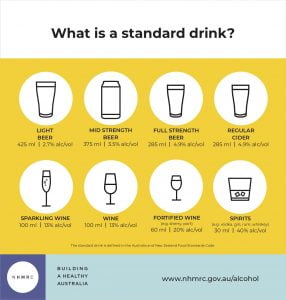As a result of four years of extensive review, the National Health and Medical Research Council (NHMRC) has released new alcohol guidelines to reduce the health risks associated with drinking alcohol.
The latest guidelines replace the previous version, published in 2009, and will reportedly underpin policy decisions and public health messaging moving forward.
The three guidelines are:
 To reduce the risk of harm from alcohol-related disease or injury, healthy men and women should drink no more than 10 standard drinks a week, and no more than four standard drinks on any one day.
To reduce the risk of harm from alcohol-related disease or injury, healthy men and women should drink no more than 10 standard drinks a week, and no more than four standard drinks on any one day.- Children and people under 18 years of age should not drink alcohol.
- Women who are pregnant or planning a pregnancy should not drink alcohol. For women who are breastfeeding, abstaining from alcohol is safest for their babies.
Of course, the less people drink, the lower the risk of harm from alcohol.
According to Professor Paul Kelly, Australia’s Acting Chief Medical Officer, there are “more than 4,000 alcohol-related deaths in Australia” each year, making this messaging and the revision of the guidelines important.
“Alcohol is linked to more than 40 medical conditions, including some cancers,” says Professor Kelly.
As previously reported by Retail Pharmacy Assistants, the Cancer Council welcomes the new drinking guidelines.
“Reducing the risk posed by alcohol demands a complex and multi-faceted approach – and the release of the guidelines is a very important part of that.
“They form part of the Australian Government’s National Alcohol Strategy, which seeks to prevent and minimise alcohol-related harms to individuals, families and communities,” adds Professor Kelly.

What is a standard drink?
A standard drink of alcohol contains 10 grams of pure alcohol.
This is approximately 285ml of full-strength beer, a can of mid-strength beer, 100ml wine or a single shot of spirits.
“We’re not telling Australians how much to drink,” says Professor Anne Kelso, CEO of NHMRC.
“We’re providing advice about the health risks, so that we can all make informed decisions in our daily lives.”



 To reduce the risk of harm from alcohol-related disease or injury, healthy men and women should drink no more than 10 standard drinks a week, and no more than four standard drinks on any one day.
To reduce the risk of harm from alcohol-related disease or injury, healthy men and women should drink no more than 10 standard drinks a week, and no more than four standard drinks on any one day.



